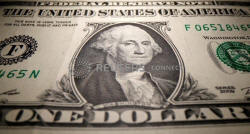Dollar bounces off 2018 lows on safe-haven buying, euro profit-taking
 Send a link to a friend
Send a link to a friend
 [January 07, 2021] By
Ritvik Carvalho [January 07, 2021] By
Ritvik Carvalho
LONDON (Reuters) -The dollar bounced off
its lowest levels since 2018 to its highest in a week on Thursday, its
gains attributed partly to safe-haven buying after violence on Capitol
Hill and profit-taking by investors who had been betting on the euro.
The dollar index, which measures the U.S. currency against a basket of
peers, rose 0.6% to 89.886.
Hundreds of President Donald Trump's supporters stormed the U.S. Capitol
on Wednesday in a bid to overturn his election defeat, battling police
in the hallways and delaying the certification of Democratic
President-elect Joe Biden's victory for hours.
Broader currency markets were largely unperturbed by the scenes of chaos
in Washington, though analysts said the dollar's rise on Thursday
indicated some safe-haven buying.
The greenback has declined more than 13% from a March 2020 peak. While
dollar positioning still remains bearish, analysts views on the
currency's prospects for 2021 are increasingly mixed.

On the one hand, some argue rising inflation expectations based on
expected U.S. government stimulus will weigh on real interest rates and
put pressure on the dollar, especially with a Federal Reserve that is
expected to stand still on rates and allow an inflation overshoot above
2%. Real interest rates are interest rates adjusted for inflation.
Conversely, some analysts say that an extended period of bearish
positioning on the dollar, as well as rising Treasury yields, could help
lift the currency over the longer term.
"The lift in both nominal yields and inflation expectations provides an
interesting backdrop for asset prices," said Jane Foley, head of FX
strategy at Rabobank.
"As long as real rates are weak the dollar could remain under pressure,
particularly given the consensus view that the Fed will allow inflation
to overshoot its 2% target."
Foley added that if the market begins to see the U.S. economy as likely
to outperform again on growth and begins to suspect that the Fed could
be less likely to lean on the yield curve, the dollar could find
support.
[to top of second column] |

A U.S. Dollar banknote is seen in this illustration taken May 26,
2020. REUTERS/Dado Ruvic/Illustration

LONG EURO
She also noted that the market remained long on the euro, and a slow vaccine
rollout in Europe could trigger some profit-taking. The single currency sank as
much as 0.6% to $1.2245.
Bank of America Merrill Lynch said the long euro market position also makes it
"one of the most vulnerable G10 currencies to an overall market risk-off" and
that, following the dollar's sell-off last year, Europe's shared currency has
now reached a long-term equilibrium.
The Australian dollar slipped 0.83% to 77.39 U.S. cents after touching a nearly
three-year high of 78.195 on Wednesday.
The dollar gained 0.6% to 103.64 yen, touching its highest level against the
Japanese currency in more than a week.
The yuan was largely flat at 6.4655 per dollar after Chinese authorities
signalled a desire for a slower pace of gains.
The remarks by the State Administration of Foreign Exchange (SAFE) on Wednesday
follow an advance of around 10% on the greenback since last May as China's
economic rebound has led the world's pandemic recovery.
The British pound traded 0.2 lower at $1.3577 as it continued to meander below
the almost three-year high of $1.3703 touched on Monday.
Bitcoin marked a fresh all-time high of $37,800 on Thursday, extending a surge
of more than 800% since mid-March. It last traded at $37,491.

(Reporting by Ritvik Carvalho; additional reporting by Kevin Buckland and
Stanley White in TOKYO; Editing by Emelia Sithole-Matarise and Alex Richardson)
[© 2021 Thomson Reuters. All rights
reserved.] Copyright 2021 Reuters. All rights reserved. This material may not be published,
broadcast, rewritten or redistributed.
Thompson Reuters is solely responsible for this content. |